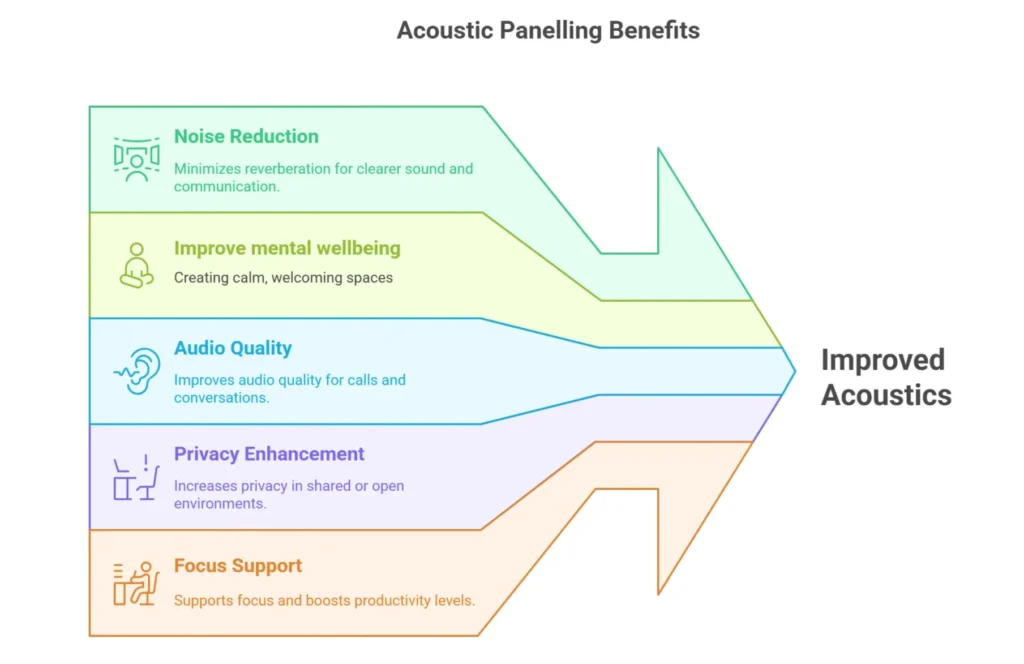What are the Benefits of Acoustic Panels?

Fri Jun 27 2025

Why acoustics are important in everyday spaces
Excessive indoor noise is more common and more disruptive than we often realise. Whether it’s an echo-filled meeting room, a loud classroom, or a distracting office environment, poor acoustics can quietly undermine comfort, concentration and wellbeing. That’s why understanding the benefits of acoustic panels is more important than ever.
A 2016 study from the National Institute of Health found that even when we can clearly hear what is being said, background noise causes the brain to work harder to process it. That extra effort comes at a cost: we become mentally fatigued more quickly and find it harder to concentrate over time. The takeaway? The more effort it takes to listen, the less stamina we have to stay engaged. In busy environments, that cognitive strain adds up fast.
It’s a clear reminder of the toll poor acoustics can take on both well-being and productivity. By absorbing excess noise and reducing reverberation, acoustic panels help create spaces that feel calmer, clearer, and far less mentally draining.
What are acoustic panels and how do they work?
Acoustic panels are engineered from fibrous materials such as; recycled polyester, fabric-wrapped glasswool or felt. Acoustic panels absorb sound waves across a broad frequency range and control reverberation, particularly when mounted on walls or ceilings. By dampening reflections, acoustic panels minimise echo and reduce background noise, resulting in clearer speech, crisper audio reproduction and an overall more comfortable, balanced sound environment.
Understanding how acoustic panels function is essential when selecting the right material, thickness, and placement for your space. If you are unsure where to start, get in touch with our team for tailored recommendations.
Benefits of Acoustic Panels in Everyday Spaces
Echo and noise reduction
Echo or reverberation is particularly noticeable in rooms with hard surfaces and minimal soft furnishings. Installing acoustic panels directly addresses the problem by reducing reflected sound energy. Acoustic panels are one of the most effective ways to reduce echo in offices, classrooms and public spaces alike.
Improved mental well-being
Sound doesn’t just affect how we hear, it impacts how we feel. Research published in Nature’s Journal of Exposure Science & Environmental Epidemiology shows that ongoing exposure to noise, even at moderate indoor levels, can increase the risk of anxiety, depression, and cognitive fatigue. These effects highlight just how important acoustic design has become in supporting everyday wellbeing.
That’s why more people are considering acoustics and mental health when designing workspaces, hospitals, and home offices. By reducing background noise and reverb, acoustic panels help create calm, restorative environments where focus and relaxation come naturally.
Clearer speech recognition
Whether in-person or on a video call, poor acoustics can blur speech and make conversations harder to follow. High reverberation times and overlapping syllables reduce clarity, leading to misunderstandings and listener fatigue. Acoustic panels absorb excess sound, helping speech come through clearer, sharper, and with less effort, on both sides of the conversation.
Speech privacy in shared spaces
In shared environments like open-plan offices or medical facilities, noise spill can be distracting and detrimental to speech privacy. In rooms with few sound-absorbing surfaces, acoustic panels enhance privacy by reducing noise transmission. Whether you’re on a call, in a team meeting, or having a private conversation, acoustic panels help create a quieter, more confidential environment.
Focus and productivity
Noise distraction is a common challenge in hybrid work and study environments. Creating a quieter space where sound doesn’t travel as far helps reduce interruptions and can lead to improved productivity. Research identifies sound and temperature as two of the main factors influencing performance.

Sound Absorption vs Soundproofing: What’s the Difference?
This is one of the most common questions we hear. While sound absorption and soundproofing are related, they serve very different purposes.
The benefits of sound absorption include reduced echo, improved sound clarity, and increased productivity. Sound absorption is achieved through acoustic panelling and is ideal for enhancing comfort, communication, and concentration across a variety of spaces.
Soundproofing, on the other hand, blocks sound from entering or leaving a space by adding mass or an isolating structure. Soundproofing is used when privacy and noise containment are the primary goals and can require structural changes.
Both approaches are essential tools in modern acoustics, but understanding the difference is key to achieving optimal results. Learn more about sound absorption versus soundproofing in our full article.
Are acoustic panels worth it?
If you’re weighing the cost of acoustic panels, the payoff is undeniable. Especially in rooms plagued by long reverberation times, muddled speech clarity or constant noise distractions. Engineered for fast, measurable improvements in sound quality, many acoustic panels are also eco-friendly and very low maintenance. They offer lasting value in both acoustic comfort and performance.
Conclusion
Acoustic panels are more than just design features; they are functional upgrades that make a real difference. Benefits of acoustic panels:
- Reduce echo and background noise
- Boost mental clarity and wellbeing
- Improve audio quality for calls and content
- Enhance privacy in shared or open spaces
- Support focus and productivity
Whether you’re outfitting a home studio, classroom, office, or healthcare facility, acoustic panels deliver one of the most impactful improvements you can make.
Need help choosing the right panels for your space? Contact us today and get expert guidance from our team.
References
Picou, Erin M., et al. “The Effects of Noise and Reverberation on Listening Effort in Adults with Normal Hearing.” Ear and Hearing, vol. 37, no. 1, 2016, pp. 1–13, https://pmc.ncbi.nlm.nih.gov/articles/PMC4684471/
Hahad, Omar, et al. “Noise and Mental Health: Evidence, Mechanisms, and Consequences.” Journal of Exposure Science & Environmental Epidemiology, vol. 35, 26 Jan. 2024, pp. 1–8, https://doi.org/10.1038/s41370-024-00642-5.
Mak, CM, and YP Lui. “The Effect of Sound on Office Productivity.” Building Services Engineering Research and Technology, vol. 33, no. 3, 18 Aug. 2011, pp. 339–345, https://doi.org/10.1177/0143624411412253.
